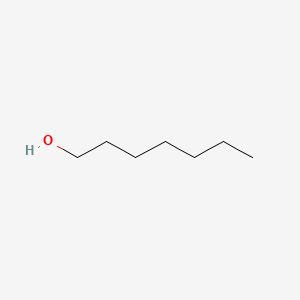| MeSH term | MeSH ID | Detail |
|---|---|---|
| Adenocarcinoma | D000230 | 166 associated lipids |
| Arrhythmias, Cardiac | D001145 | 42 associated lipids |
| Diabetes Mellitus, Experimental | D003921 | 85 associated lipids |
| Eye Burns | D005126 | 13 associated lipids |
| Cardiomegaly | D006332 | 31 associated lipids |
| Heart Injuries | D006335 | 6 associated lipids |
| Hypertension | D006973 | 115 associated lipids |
| Hypertension, Pulmonary | D006976 | 32 associated lipids |
| Neovascularization, Pathologic | D009389 | 39 associated lipids |
| Occupational Diseases | D009784 | 42 associated lipids |
| Radiation Injuries, Experimental | D011833 | 11 associated lipids |
| Tachycardia, Ectopic Atrial | D013612 | 1 associated lipids |
| Wounds, Gunshot | D014948 | 2 associated lipids |
| Reperfusion Injury | D015427 | 65 associated lipids |
| Tachycardia, Ventricular | D017180 | 9 associated lipids |
| Ventricular Dysfunction, Left | D018487 | 33 associated lipids |
n-heptanol
N-heptanol is a lipid of Fatty Acyls (FA) class. N-heptanol is associated with abnormalities such as Corneal Neovascularization. N-heptanol often locates in Epithelium and Structure of corneal epithelium. The related lipids are Heptanol.
Cross Reference
Introduction
To understand associated biological information of n-heptanol, we collected biological information of abnormalities, associated pathways, cellular/molecular locations, biological functions, related genes/proteins, lipids and common seen animal/experimental models with organized paragraphs from literatures.
What diseases are associated with n-heptanol?
n-heptanol is suspected in Corneal Neovascularization and other diseases in descending order of the highest number of associated sentences.
Related references are mostly published in these journals:
| Disease | Cross reference | Weighted score | Related literature |
|---|
Possible diseases from mapped MeSH terms on references
We collected disease MeSH terms mapped to the references associated with n-heptanol
PubChem Associated disorders and diseases
What pathways are associated with n-heptanol
There are no associated biomedical information in the current reference collection.
PubChem Biomolecular Interactions and Pathways
Link to PubChem Biomolecular Interactions and PathwaysWhat cellular locations are associated with n-heptanol?
Visualization in cellular structure
Associated locations are in red color. Not associated locations are in black.
Related references are published most in these journals:
| Location | Cross reference | Weighted score | Related literatures |
|---|
What functions are associated with n-heptanol?
There are no associated biomedical information in the current reference collection.
What lipids are associated with n-heptanol?
Related references are published most in these journals:
| Lipid concept | Cross reference | Weighted score | Related literatures |
|---|
What genes are associated with n-heptanol?
There are no associated biomedical information in the current reference collection.
What common seen animal models are associated with n-heptanol?
There are no associated biomedical information in the current reference collection.
NCBI Entrez Crosslinks
All references with n-heptanol
Download all related citations| Authors | Title | Published | Journal | PubMed Link |
|---|---|---|---|---|
| Godard NM et al. | Paracrine factors from cumulus-enclosed oocytes ensure the successful maturation and fertilization in vitro of denuded oocytes in the cat model. | 2009 | Fertil. Steril. | pmid:18692794 |
| Koutsioulis D et al. | Novel endo-alpha-N-acetylgalactosaminidases with broader substrate specificity. | 2008 | Glycobiology | pmid:18635885 |
| Ye JH et al. | Functional connectivity map of retinal ganglion cells for retinal prosthesis. | 2008 | Korean J. Physiol. Pharmacol. | pmid:19967072 |
| Liaw YF et al. | Asian-Pacific consensus statement on the management of chronic hepatitis B: a 2008 update. | 2008 | Hepatol Int | pmid:19669255 |
| Malvindi MA et al. | Rod-shaped nanocrystals elicit neuronal activity in vivo. | 2008 | Small | pmid:18844306 |
| Smith DW et al. | Mice lacking NKCC1 have normal olfactory sensitivity. | 2008 | Physiol. Behav. | pmid:17719611 |
| Hung J and Colicos MA | Astrocytic Ca(2+) waves guide CNS growth cones to remote regions of neuronal activity. | 2008 | PLoS ONE | pmid:19002247 |
| Chen H et al. | Expressing exogenous functional odorant receptors in cultured olfactory sensory neurons. | 2008 | Neural Dev | pmid:18786248 |
| Biktashev VN et al. | Generation and escape of local waves from the boundary of uncoupled cardiac tissue. | 2008 | Biophys. J. | pmid:18212013 |
| Kurebayashi N et al. | Aberrant cell-to-cell coupling in Ca2+-overloaded guinea pig ventricular muscles. | 2008 | Am. J. Physiol., Cell Physiol. | pmid:18385286 |
